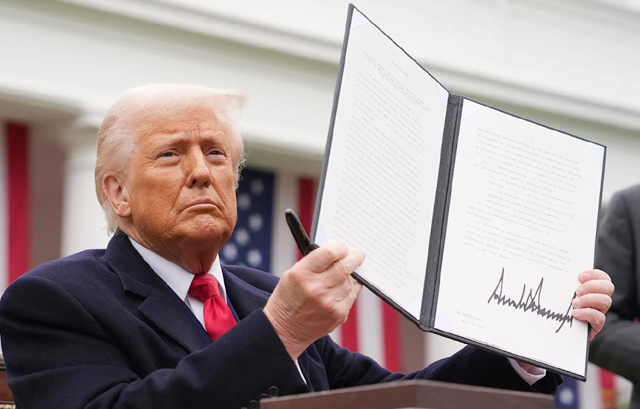By Daily Maverick | 2025-04-05

Markets plunged, currencies convulsed and analysts scrambled to make sense of things after US President Donald Trump’s 2 April announcement of sweeping “reciprocal” tariffs — starting at 10% and reaching as high as 54% for some countries.
South Africa was hit with a US import tariff of 30%.
Trump pitched the move as a recalibration of fairness, but the shockwave was geopolitical, not just financial. South Africa, though only moderately exposed to US trade flows in comparison to other nations, is squarely in the path of collateral damage.
While some exports were spared, others such as agriculture and auto parts face new uncertainty. For ordinary South Africans, the effects will be felt not only in export margins but in inflation, employment and interest rate policy.
“Agoa has essentially ended tonight,” said trade expert Donald MacKay.
MacKay, the head of XA Global Trade Advisors, said the new 30% duty on SA, coming on top of the 25% smacked on auto imports from all countries on 26 March, had effectively negated SA’s lucrative duty-free exports into the US under the African Growth and Opportunity Act (Agoa).
South Africa is, in any case, likely to be booted out of the Agoa programme soon because of the Trump administration’s hostility to many of SA’s domestic and foreign policies. Agoa itself is due to expire in September and it seems unlikely to be renewed, given Trump’s extreme dislike of non-reciprocal or any free trade.
MacKay noted in a video message to his clients that the Trump administration had imposed the 30% tariff on SA imports based on a formula of halving what it said was the average tariff of 60% for US imports into SA.
But MacKay said SA’s tariffs on US imports averaged only 7.5%. “If we follow President Trump’s logic, what we should be facing is something like a 3.75% tariff instead. Of course, facts don’t matter that much here.”
He said that last year, SA exported about R153-billion worth of products to the US, half of which were minerals. Official sources said 35-40% of SA’s 2024 exports would be exempt from the 30% tariff, mostly minerals and energy.
However, most exports under Agoa will not be exempt, and so, said MacKay: “Agoa, to my mind, has essentially ended tonight … with a 30% tariff, the 3.5% benefit on average that we get out of Agoa has truly become meaningless.”
‘Move fast and break things’
“I think many underestimated this,” said Jee-A van der Linde, senior economist at Oxford Economics Africa.
“People were blindsided in the same way they were with USAID removal. The Trump administration moves fast and it slices deep,” he said — echoing the ideology of many of the Silicon Valley elites in Trump’s close orbit, and a catchphrase that has become associated with them: “Move fast and break things.”
And indeed, much seems to have been broken.
Tariffs: reciprocal, retributive or reckless?
Trump’s tariffs have been framed as a move toward “fair trade”, designed to equalise import/export flows by applying pressure to countries that have trade surpluses with the US.
Unlike WTO-sanctioned most-favoured-nation tariffs, these new rates are alleged to aim at rebalancing bilateral trade asymmetries — regardless of their origin or structural logic.
What’s been publicly shared is less a technical instrument than a political provocation dressed up in pseudo-academic terms. The administration’s justification rests on a US Trade Representative formula — quoted by White House spokesperson Kush Desai — that attempts to mechanically adjust tariff rates until trade balances equalise.
While the formula appears somewhat nuanced, the calculation itself is simple: US exports to a country minus US imports from that country, divided by US imports from that country.
If that seems too simple, it’s because it’s the economic equivalent of a hammer that indiscriminately hits and hurts the hand that holds it.
Theoretically, the equation imposes a penalty where the US imports more than it exports. In practice, it collapses under scrutiny. Elasticity assumptions vary wildly between sectors, tariff passthroughs differ by supply chain, and the inclusion of “non-tariff barriers” in the tariff base is a political sleight of hand.
Red flags
“This is not really about economics,” said Van der Linde. “This is about sending a message. Even an economics 101 student would look at this and say: ‘What is this?’ There’s no coefficient for the relationship between countries. That should be the first red flag.”
Old Mutual Investment Group’s wealth strategist Izak Odendaal echoed the critique in an interview with Daily Maverick. “It’s just a bit crazy,” he said. “There’s no real link to economic theory or actual trade dynamics. If you’re serious about trade fairness, you don’t go after Lesotho with a 50% tariff.”
And yet the US has.
Economists highlighted inconsistencies that raise further red flags. Among them: the inclusion of platinum group metals (PGMs) in trade volume calculations despite their exemption from tariffs.
Odendaal was blunt in his assessment: “It’s 1950s industrial policy thinking in a world of global supply chains. Trade today is about intermediate goods. You can end up hurting your own exporters just as much as foreign ones.”
The point Odendaal makes is a valid one — the materials for products are not sourced or mined, consolidated and manufactured in the same country or even region; in today’s world, intermediate goods (those that have some form of modification but have not yet reached the final stage of a product, say, the lithium battery cells in an electric vehicle) transit borders many times before they make it into the end product destined for the country they are sold in.
The blanket approach to these tariffs taken by the Trump administration is the economic equivalent of flipping over the Monopoly board — while you are winning the game.
Not all exports are equal
While PGMs were spared — probably as these are natural resources lacking in the US — not all South African exports were so lucky.
The Minerals Council SA welcomed the exclusion of PGMs, manganese, coal and gold — which together comprise 76% of South African mineral exports to the US — but warned of broader consequences.
“Despite the exclusions, we remain concerned about the adverse impact on sentiment and global growth,” said the chief economist at the Minerals Council, Hugo Pienaar. “Even PGMs are not immune. Tariffs on vehicles mean fewer sales, which hits demand for autocatalysts.”
Iron ore and diamonds now face 30% tariffs. In the agricultural sector, macadamia, citrus and wine exporters are already reporting delays, uncertainty and pricing renegotiations. While not as headline-grabbing, these marginal contractions ripple across employment nodes, logistics corridors and port activity.
Effect on automotive sector
The automotive sector is more exposed than the National Treasury has acknowledged. Trump’s 25% blanket tariff on imported vehicles affects supply chains and deters future investment in high-value manufacturing.
BMW and Mercedes-Benz, which export significant numbers of vehicles to the US, would be among the hardest hit by the tariff, said MacKay.
He added that it was not clear if the 30% tariff would be added to the 25% auto tariff hike, but official sources told Daily Maverick it would not be. Still, a 25% increase in import tariffs on vehicles would probably be more than enough to wipe out any advantage SA-made cars now enjoy in the US market.
MacKay said it was not clear how the US would replace the SA cars. “It’s very easy to sign off on a tariff policy, much harder to build a factory. The US is not miraculously going to have the capacity to build all of these cars, so car prices will certainly rise.”
He also noted that the new import tariffs had not been applied evenly. For instance, Brazil, which competes with SA vehicles in the US market, had only received a 10% tariff increase.
“It is a sector that could be affected internationally … [these tariffs] expose concentration risks and challenge our beneficiation strategies,” said Minister of Trade and Industry Parks Tau.
Poultry industry
The White House fact sheet issued on Wednesday to explain the tariff increases said: “For decades, South Africa has imposed animal health restrictions that are not scientifically justified on US pork products, permitting a very limited list of US pork exports to enter South Africa.
“South Africa also heavily restricts US poultry exports through high tariffs, anti-dumping duties, and unjustified animal health restrictions. These barriers have contributed to a 78% decline in US poultry exports to South Africa, from $89-million in 2019 to $19-million in 2024.”
Dan Halstrom, the president and CEO of the US Meat Export Federation (USMEF), told Daily Maverick: “President Trump’s executive order definitely provides more clarity on the administration’s approach to reciprocal tariffs, and we appreciate the White House bringing attention to the markets in which US exports face significant trade barriers.
“USMEF’s main concern is obviously how our trading partners will react. We are hopeful that they will focus on eliminating barriers to trade rather than imposing restrictive countermeasures.”
US poultry industry sources indicated they were not aware of any outstanding issues on US poultry imports into SA.
The global impact — seeing red
The global fallout was immediate, and reflected clearly the sheer unexpected nature of the tariffs, both within the US and internationally.
The S&P 500 fell by 4%, the Nasdaq lost 5%, and the Dow Jones shed 1,500 points. Wall Street’s volatility index, the VIX, spiked to 27 — its highest since late 2023.
The rand — already on the back foot because of GNU Budget uncertainty — dropped further, breaching R19.00/$ intraday. The contagion wasn’t contained to equities — sovereign bonds lost ground, and gold rose in a classic flight to safety.
South African pension funds, particularly those with offshore equity exposure, saw portfolio values fall in lockstep with developed market indices. Meanwhile, input inflation expectations ticked up.
“Trade wars are bad for everyone. Even exempt sectors suffer from slower global growth,” said Minerals Council CEO Mzila Mthenjane. “And when growth contracts, so does demand — even for metals we think are protected.”
Cost pressure
While tariffs may not yet show up on supermarket shelves, cost pressure is already trickling down.
Struggling export-facing SMEs will now have further challenges to maintain offshore clients amid contractual uncertainty. Payments have been delayed, shipments held up and terms revised. The lack of clarity from Washington only deepens the instability.
A weaker rand has made imports of fuel, fertiliser and agricultural chemicals more expensive. South Africa imports roughly 80% of its fertiliser needs, and farmers are warning of rising input costs just ahead of the next planting season.
Pension funds with global diversification have also taken a hit. With US markets in correction territory and the rand volatile, portfolio managers are juggling risk-on and risk-off trade-offs with few clear signals.
“Companies don’t really have time to adjust,” said Van der Linde. “Smaller players will be hit first.”
Populism vs policy — a Trumpian zero-sum game
Analysts agree this is less about fairness and more about political optics.
“This isn’t economics,” said Van der Linde. “It’s politics masquerading as policy.”
Trump’s logic reflects a retreat from multilateralism and a push for managed trade — one governed less by institutional negotiation than by the White House diktat: bend the knee or die.
“The idea that he would be a dealmaker has gone out the window,” said Odendaal. “There doesn’t seem to be a clear negotiation process here.”
With Agoa’s future in question and the US leaning further into trade nationalism, the implications for South Africa’s medium-term export strategy are sobering — and may be the final nail in the coffin for the longstanding bilateral agreement.
For now, businesses and policymakers must adapt to what Van der Linde calls “a non-equilibrium world” — a reality where unpredictability is the new norm.
share story
Post Your Comments Below

THE MTN Bushfire Festival launch will be underway this evening.
The festival is scheduled f...

As the highly anticipated Ingwenyama Cup knockout tournament final draws near, National Commissio...

Markets plunged, currencies convulsed and analysts scrambled to make sense of things after US Pre...

The Eswatini Road Transport Council will have no option but to effect a 100 per cent bus fare hik...
All material © Swazi Observer. Material may not be published or reproduced in any form without prior written permission.
Design by Real Image Internet